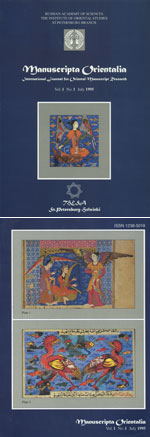|
|
| |

|

|
Akimushkin O. The Sources of “The Treatise on Calligraphers and Painters” by Qāzī Ahmad Qumī // Manuscripta Orientalia. Vol. 1, No 1, July 1995. Pp. 5-11.
Almost 50 years ago the scholarly world was introduced to the outstanding document of the Persian literary culture The Treatise on Calligraphers and Painters by Qāzī Ahmad Ibrāhīm Qumī (born 17 rabī' I 953/May 18, І546), which is a bibliographical dictionary of the “book art”, that of calligraphers, painters, decorators and masters of ornamentation. The appearance of such a document was a real sensation: for the first time scholars got an original work, where information on the Persian masters of qalam and brush was arranged chronologically up to the end of the 16th century. The material of the Treatise considerably expanded our knowledge about the book painting, the volume of book production, the prestige of this kind of labour as well as the popularity of illuminated manuscripts in Iran and among its neighbors in the Middle Ages.
It should be noted, that the name of the author, Qāzī Ahmad, was well known to the specialists long before the publication of the Russian and English translations of the Treatise. He and his two works (Treatise and the fifth volume of the chronicle Khulāsat al-tawārīkh) were discussed at lenghth in articles by W. Hintz, B. Zakhoder, C. Edwards, Zohreh Da'i-zadeh, Sh. Qadiri, Gh. Sarvar, H. Nakhchevani and A. Suhayli-Khwansari. The author of the present article has written already on the stages of the making of this work, which survived in two versions (1004/1596— Treatise and around 1016/1607— 8 — Gulistān-i hunar), which are called conventionally “the Iranian” and “the Indian”. We should note that the first version is present in two variants: that of 1004/1596 (the original) and of 1007/1598—99 (a considerably expanded original version). At present we know three copies of the Treatise, i.e. of the first version, in two variants (Museum Salar Jang, Haidarabad, India, call number T-K. 1; the State museum of the Arts of the Peoples of the Orient (GMINV), Moscow, Russia, call number M.Or.156; the St. Petersburg Branch of the Institute of Oriental Studies, call number В 4722. The last two copies present the expanded variant) and eight copies of Gulistān-i hunar, i.e. of the second version (Museum
Salar Jang, Haidarabad, India, call number T-K.2; the former Library of Saltanati, Teheran, Iran, call number 2286; six copies belonging to the private collections of Z. Da'i-zadeh (India), A. Iqbal, H. Nakhchevani, M. Baya-ni, A. Suhayli-Khansari and A. Gulchin-i Ma'ani (Iran). The last three are copies from H. Nakhchevani's manuscript).
As it was mentioned above, the contents of the Treatise is a biographical dictionary of the masters of hand-written book (excluding binders). According to the established professional tradition, Qāzī Ahmad included there the famous masters of previous generations adding to this pantheon some of his contemporaries. For this purpose he chose only those craftsmen whose work was highly appreciated during their lifetime by connoisseurs, professionals and the patrons of art. It should be noted that the composition of the Treatise is close to the prefaces of albums (muraqqa) — collections of works arranged like concertina or made of separate folios (qit'eh), which had on one side artistically composed samples of writing by one or several calligraphers, on the other — miniatures or examples of calligraphy. The borders of such a folio, as well as the space between the samples, were filled with the exquisite decorative ornamentation. It is well known that albums of this kind were widely spread among the author's contemporaries belonging to the elite circles.
In other words, the accurate composition, structure and architectonics of the Treatise (masters of the classical “six” scripts, ta'līq, nasta'līq, painters, masters of the “book craft”) obviously prove that Qazi Ahmad was planning his work within the limits of some well-established genre. Alongside with the fact that his work greatly reminds of a verbose preface to an extensive never-to be-completed album overloaded with facts and details, Qāzī Ahmad became the founder a new trend of Persian biographical literature — the biographical dictionary of the masters of manuscripts in a broad context. It is already ascertained that evristics is one of the main components of the source-analysis of written documents regardless of their genre. It is expected to reveal the sources of the document, its relation to earlier documents, the scale and volume of borrowed facts and materials, its influence on the later documents, etc. This is of special significance if applied, in particular, to the Persian medieval documents, since most of the medieval authors, following their specific idea on the authors' rights and intellectual property, often did not mention their predecessors, whose works and materials were borrowed by them. We have many examples of this in the history of Persian literature. Examples of the opposite are also present (the latter even grow in number in the course of time). Our author was not an exception. There are no references to the sources he used; this research was left to the following generations. Still, he mentioned the poetic work on calligraphers by Sultān-'Alī Mashhadī, apparently because it is included completely into his Treatise. Here we shall mention the manuscript sources which were used by Qāzī Ahmad, and which we managed to identify… PDF-files PDF-files
The entire paper
Keywords
Manuscripta Orientalia, selected papers
Qāzī Ahmad Qumī
“The Treatise on Calligraphers and Painters”
|
|
|
|
Random news: Announcements |
|
The Second All-Russia Hebraistics Session will be held at the IOM RAS on March 12, 2025. The conference program is now available. |
|
Read more...
|
|
|
|
|

